Experimental Validation of a Numerical Model of a Ventilated Façade with Horizontal and Vertical Open Joints
Abstract
:1. Introduction
2. Materials and Methods: Experimental Test Bench
3. Numerical Simulation Model
3.1. Description of the Geometry and the Boundary Conditions
3.2. Main Characteristics of the Mesh
3.3. Main Characteristics of the CFD Models
4. Results and Discussion
5. Conclusions
- The 3D CFD model has been validated with experimental data from a laboratory façade evaluated with the Stereo-PIV technique and thermal monitoring.
- The numerical model has been developed considering the same geometry, materials and boundary conditions as the experimental laboratory model.
- The incident solar radiation has been modelled as an internal heat source in the exterior face of the panels (absorbed radiation). Heating conditions used to validate the CFD-model correspond to 460 W/m2.
- The numerical simulations have been performed for steady-state conditions, and different radiation and turbulence models were tested.
- Experimental and numerical data have been compared in three vertical planes of the cavity perpendicular to the panels. As a result, the DO radiation model and k-ε RNG turbulence model have been selected to numerically simulate the OJVFs performance due to the low discrepancies between experimental and numerical temperature and velocity data.
- Similar velocity and temperature trends along the whole height are repeated in OJVFs regardless of their experimental or simulated origin. Slight differences have been found in the behaviour of the air inside the cavity. In both cases, a complex, three-dimensional ventilation airflow is induced by natural convection. In conclusion, the open joints allow an effective ventilation flow in the cavity, reducing the heat transfer.
Author Contributions
Funding
Acknowledgments
Conflicts of Interest
References
- Directive 2010/31/EU of the European Parliament and of the Council of 19 May 2010 on the Energy Performance of Buildings. Available online: https://eur-lex.europa.eu/legal-content/ES/TXT/?uri=celex%3A32010L0031 (accessed on 4 November 2019).
- Directive 2012/27/EU of the European Parliament and of the Council of 25 October 2012 on energy efficiency, amending Directives 2009. Available online: https://eur-lex.europa.eu/legal-content/ES/TXT/?uri=celex%3A32012L0027 (accessed on 4 November 2019).
- The National Energy Code of Canada for Buildings 2017 (NECB 2017). National Research Council of Canada. Canadian Commission on Building and Fire Codes. Available online: https://nrc.canada.ca/en (accessed on 4 November 2019).
- Building Energy Codes Program (BECP). U.S. Department of Energy (DOE). Available online: https://www.energycodes.gov/adoption (accessed on 4 November 2019).
- Ministry of Construction of the People’s Republic of China. China Design Standard for Energy Efficiency of Residential Buildings; JGJ 26-2010: In Severe Cold and Cold Zones; Ministry of Construction of the People’s Republic of China: Beijing, China, 2010.
- Oropeza-Perez, I.; Alberg Østergaard, P. Active and passive cooling methods for dwellings: A review. Renew. Sustain. Energy Rev. 2018, 82, 531–544. [Google Scholar] [CrossRef]
- Ascione, F.; De Masi, R.F.; de Rossi, F.; Ruggiero, S.; Vanoli, G.P. Optimization of building envelope design for nZEBs in Mediterranean climate: Performance analysis of residential case study. Appl. Energy 2016, 183, 938–957. [Google Scholar] [CrossRef]
- Soutullo, S.; Sánchez, M.N.; Enríquez, R.; Olmedo, R.; Jiménez, M.J. Bioclimatic vs conventional building: Experimental quantification of the thermal improvements. Energy Procedia 2017, 122, 823–828. [Google Scholar] [CrossRef]
- Berardi, U.; Bisegna, F.; Santoli, L.; Evangelisti, L.; Ferreira, P.; Gori, P.; Guattari, C.; Klingenberg, K.; Mattoni, B.; Wright, G.S. From Efficient to Sustainable and Zero Energy Consumption Buildings. In Handbook of Energy Efficiency in Buildings: A Life Cycle Approach; Asdrubali, F., Desideri, U., Eds.; Butterworth-Heinemann: Oxford, UK, 2019; Chapter 3; pp. 75–205. [Google Scholar]
- Kosutovaa, K.; van Hooffa, T.; Vanderwel, C.; Blockena, B.; Hensen, J. Cross-ventilation in a generic isolated building equipped with louvers: Wind-tunnel experiments and CFD simulations. Build. Environ. 2019, 154, 263–280. [Google Scholar] [CrossRef]
- Saadatian, O.; Sopian, K.; Lim, C.H.; Asim, N.; Sulaiman, M.Y. Trombe walls: A review of opportunities and challenges in research and development. Renew. Sustain. Energy Rev. 2012, 16, 6340–6351. [Google Scholar] [CrossRef]
- Pergolini, M.; Ulpiani, G.; Shehi, O.; Di Perna, C.; Stazi, F. Controlled inlet airflow in ventilated facades: A numerical analysis. In Proceedings of the 10th International Conference IAQVEC 2019: Indoor Air Quality, Ventilation and Energy Conservation in Buildings, Bari, Italy, 5–7 September 2019; Volume 609, p. 032009. [Google Scholar]
- Evins, R. A review of computational optimization methods applied to sustainable building design. Renew. Sustain. Energy Rev. 2013, 22, 230–245. [Google Scholar] [CrossRef]
- Harish, V.S.K.V.; Kumar, A. A review on modelling and simulation of building energy systems. Renew. Sustain. Energy Rev. 2016, 56, 1272–1292. [Google Scholar] [CrossRef]
- Crawley, D.B.; Hand, J.W.; Kummert, M.; Griffith, B.T. Contrasting the capabilities of building energy performance simulation programs. Build. Environ. 2008, 43, 661–673. [Google Scholar] [CrossRef] [Green Version]
- Ramponi, R.; Blocken, B. CFD simulation of cross-ventilation flow for different isolated building configurations: Validation with wind tunnel measurements and analysis of physical and numerical diffusion effects. J. Wind Eng. Ind. Aerodyn. 2012, 104, 408–418. [Google Scholar] [CrossRef]
- Suárez, M.J.; Gutiérrez, A.J.; Parrondo, J.L.; Blanco, E. Analysis of an Attached Sunspace with a Thermal Inertia Floor. Energies 2018, 11, 1136. [Google Scholar] [CrossRef] [Green Version]
- Jomehzadeh, F.; Nejat, P.; Calautit, J.K.; Yusof, M.B.M.; Zaki, S.A.; Hughes, B.R.; Yazid, M.N.A.W.M. A review on windcatcher for passive cooling and natural ventilation in buildings, Part 1: Indoor air quality and thermal comfort assessment. Renew. Sustain. Energy Rev. 2017, 70, 736–756. [Google Scholar] [CrossRef]
- Wang, Y.; Shukla, A.; Liu, S. A state of art review on methodologies for heat transfer and energy flow characteristics of the active building envelopes. Renew. Sustain. Energy Rev. 2017, 78, 1102–1116. [Google Scholar] [CrossRef]
- Suárez, M.J.; Soutullo, S.; Navarro, A.; Blanco, E. Heat collection in an attached sunspace. Renew. Energy 2020, 145, 2144–2150. [Google Scholar] [CrossRef]
- Santiago, J.L.; Rivas, E.; Sanchez, B.; Buccolieri, R.; Martin, F. The Impact of Planting Trees on NOx Concentrations: The Case of the Plaza de la Cruz Neighborhood in Pamplona (Spain). Atmosphere 2017, 8, 131. [Google Scholar] [CrossRef] [Green Version]
- Liu, S.; Kwok, Y.T.; Lau, K.K.L.; Chan, P.W.; Ng, E. Investigating the energy saving potential of applying shading panels on opaque façades: A case study for residential buildings in Hong Kong. Energy Build. 2019, 193, 78–91. [Google Scholar] [CrossRef]
- Katsaprakakis, D.A.; Georgila, K.; Zidianakis, G.; Michopoulos, A.; Psarras, N.; Christakis, D.G.; Kanouras, S. Energy upgrading of buildings. A holistic approach for the natural history museum of Crete, Greece. Renew. Energy 2017, 114, 1306–1332. [Google Scholar] [CrossRef]
- Fantucci, S.; Serra, V. Investigating the performance of reflective insulation and low emissivity paints for the energy retrofit of roof attics. Energy Build. 2019, 182, 300–310. [Google Scholar] [CrossRef]
- Sanchez, E.; Rolando, A.; Sant, R.; Ayuso, L. Influence of natural ventilation due to buoyancy and heat transfer in the energy efficiency of a double skin facade building. Energy Sustain. Dev. 2016, 33, 139–148. [Google Scholar] [CrossRef] [Green Version]
- Ziasistani, N.; Fazelpour, F. Comparative study of DSF, PV-DSF and PV-DSF/PCM building energy performance considering multiple parameters. Sol. Energy 2019, 187, 115–128. [Google Scholar] [CrossRef]
- Huang, J.; Yu, J.; Yang, H. Effects of key factors on the heat insulation performance of a hollow block ventilated wall. Appl. Energy 2018, 232, 409–423. [Google Scholar] [CrossRef]
- Zhang, C.; Gang, W.; Xu, X.; Li, L.; Wang, J. Modelling, experimental test, and design of an active air permeable wall by utilizing the low-grade exhaust air. Appl. Energy 2019, 240, 730–743. [Google Scholar] [CrossRef]
- Yang, J.; Wang, J.; Xiong, F.; Liang, H.; Li, Y. Assessment of Building External Wall Thermal Performance Based on Temperature Deviation Impact Factor under Discontinuous Radiant Heating. J. Therm. Sci. 2019, 28, 1129–1140. [Google Scholar] [CrossRef]
- Halawa, E.; Ghaffarianhoseini, A.; Ghaffarianhoseini, A.; Trombley, J.; Hassan, N.; Baig, M.; Yusoff, S.Y.; Ismail, M.A. A review on energy conscious designs of building façades in hot and humid climates: Lessons for (and from) Kuala Lumpur and Darwin. Renew. Sustain. Energy Rev. 2018, 82, 2147–2161. [Google Scholar] [CrossRef]
- Bikas, D.; Tsikaloudaki, K.; Kontoleon, K.J.; Giarma, C.; Tsoka, S.; Tsirigoti, D. Ventilated Facades: Requirements and Specifications Across Europe, International Conference on Sustainable Synergies from Buildings to the Urban Scale, SBE16. Procedia Environ. Sci. 2017, 38, 148–154. [Google Scholar] [CrossRef]
- Barbosa, S.; Ip, K. Perspectives of double skin façades for naturally ventilated buildings: A review. Renew. Sustain. Energy Rev. 2014, 40, 1019–1029. [Google Scholar] [CrossRef]
- Nizovtsev, M.I.; Letushko, V.N.; Yu. Borodulin, V.; Sterlyagov, A.N. Experimental studies of the thermo and humidity state of a new building facade insulation system based on panels with ventilated channels. Energy Build. 2020, 206, 109607. [Google Scholar] [CrossRef]
- Kalyanova Larsen, O.; Liu, M. Computational performance prediction of Double-Skin Ventilated Facade. In Building Performance Simulation and Characterisation of Adaptive Facades—Adaptive Facade Network; Favoino, F., Loonen, R.C.G.M., Doya, M., Goia, F., Bedon, C., Babich, F., Eds.; TU Delft Open: Delft, The Netherlands, 2018; Chapter 9; pp. 89–94. [Google Scholar]
- Recatala, M.A.; Morales, S.G.; van den Bossche, N. Experimental assessment of rainwater management of a ventilated façade. J. Build. Phys. 2018, 42, 38–67. [Google Scholar] [CrossRef]
- Yang, H.; Xie, Y.; Yuan, J. Potential of self-drying siding with raised air cavities for building envelopes. Build. Environ. 2019, 152, 172–181. [Google Scholar] [CrossRef]
- Souza, L.C.O.; Souza, H.A.; Rodrigues, E.F. Experimental and numerical analysis of a naturally ventilated double-skin façade. Energy Build. 2018, 165, 328–339. [Google Scholar] [CrossRef]
- Wang, Y.; Chen, Y.; Li, C. Airflow modeling based on zonal method for natural ventilated double skin façade with Venetian blinds. Energy Build. 2019, 191, 211–223. [Google Scholar] [CrossRef]
- Dama, A.; Angeli, D.; Kalyanova Larsen, O. Naturally ventilated double-skin façade in modeling and experiments. Energy Build. 2017, 144, 17–29. [Google Scholar] [CrossRef] [Green Version]
- Zhang, T.; Yang, H. Flow and heat transfer characteristics of natural convection in vertical air channels of double-skin solar façades. Appl. Energy 2019, 242, 107–120. [Google Scholar] [CrossRef]
- Giancola, E.; Sánchez, M.N.; Friedrich, M.; Kalyanova Larsen, O.; Nocente, A.; Avesani, S.; Babich, F.; Goia, F. Possibilities and challenges of different experimental techniques for airflow characterisation in the air cavities of façades. J. Facade Des. Eng. 2018, 6, 34–48. [Google Scholar]
- Ibañez-Puy, M.; Vidaurre-Arbizu, M.; Sacristán-Fernández, J.A.; Martín-Gómez, C. Opaque ventilated façades: Thermal and energy performance review. Renew. Sustain. Energy Rev. 2017, 79, 180–191. [Google Scholar] [CrossRef]
- Stazi, F.; Ulpiani, G.; Pergolini, M.; Magni, D.; Perna, C.D. Experimental comparison between three types of opaque ventilated facades. Open Constr. Build. Technol. J. 2018, 12, 296–308. [Google Scholar] [CrossRef] [Green Version]
- Astorqui, J.S.C.; Porras-Amores, C. Ventilated Façade with double chamber and flow control device. Energy Build. 2017, 149, 471–482. [Google Scholar] [CrossRef]
- Diallo, T.M.O.; Zhao, X.; Dugue, A.; Bonnamy, P.; Miguel, F.J.; Martinez, A.; Theodosiou, T.; Liu, J.S.; Brown, N. Numerical investigation of the energy performance of an Opaque Ventilated Façade system employing a smart modular heat recovery unit and a latent heat thermal energy system. Appl. Energy 2017, 205, 130–152. [Google Scholar] [CrossRef]
- Fantucci, S.; Marinosci, C.; Serra, V.; Carbonaro, C. Thermal performance assessment of an opaque ventilated façade in the summer period: Calibration of a simulation model through in-field measurements. Energy Procedia 2017, 111, 619–628. [Google Scholar] [CrossRef] [Green Version]
- Peci Lopéz, F.; de Adana Santiago, M.R. Sensitivity study of an opaque ventilated facade in the winter season in different climate zones in Spain. Renew. Energy 2015, 75, 524–533. [Google Scholar] [CrossRef]
- Gagliano, A.; Nocera, F.; Aneli, S. Thermodynamic analysis of ventilated façades under different wind conditions in summer period. Energy Build. 2016, 122, 131–139. [Google Scholar] [CrossRef]
- Soutullo, S.; Sánchez, M.N.; Enríquez, R.; Jiménez, M.J.; Heras, M.R. Empirical estimation of the climatic representativeness in two different areas: Desert and Mediterranean climates. Energy Procedia 2017, 122, 829–834. [Google Scholar] [CrossRef]
- Agathokleous, R.A.; Kalogirou, S.A. Part I: Thermal analysis of naturally ventilated BIPV system: Experimental investigation and convective heat transfer coefficients estimation. Sol. Energy 2018, 169, 673–681. [Google Scholar] [CrossRef]
- Agathokleous, R.A.; Kalogirou, S.A. Part II: Thermal analysis of naturally ventilated BIPV system: Modeling and Simulation. Sol. Energy 2018, 169, 682–691. [Google Scholar] [CrossRef]
- Lai, C.; Hokoi, S. Experimental and numerical studies on the thermal performance of ventilated BIPV curtain walls. Indoor Built Environ. 2017, 26, 1243–1256. [Google Scholar] [CrossRef]
- Luo, Y.; Zhang, L.; Wang, X.; Xie, L.; Liu, Z.; Wu, J.; Zhang, Y.; He, X. A comparative study on thermal performance evaluation of a new double skin façade system integrated with photovoltaic blinds. Appl. Energy 2017, 199, 281–293. [Google Scholar] [CrossRef]
- Li, Y.; Darkwa, J.; Kokogiannakis, G. Heat transfer analysis of an integrated double skin façade and phase change material blind system. Build. Environ. 2017, 125, 111–121. [Google Scholar] [CrossRef]
- Kylili, A.; Fokaides, P.A. A High Performance Controlled Temperature Building Shell for the Sustainable Upgrading of Buildings. Procedia Environ. Sci. 2017, 38, 130–139. [Google Scholar] [CrossRef]
- Giancola, E.; Sanjuan, C.; Blanco, E.; Heras, M.R. Experimental assessment and modelling of the performance of an open joint ventilated façade during actual operating conditions in mediterranean climate. Energy Build. 2012, 54, 363–375. [Google Scholar] [CrossRef]
- Stazi, F.; Tomassoni, F.; Vegliò, A.; Di Perna, C. Experimental evaluation of ventilated walls with an external clay cladding. Renew. Energy 2011, 36, 3373–3385. [Google Scholar] [CrossRef]
- Blanco, J.M.; Buruaga, A.; Rojí, E.; Cuadrado, J.; Pelaz, B. Energy assessment and optimization of perforated metal sheet doubleskin facades through Design Builder; A case study in Spain. Energy Build. 2016, 111, 326–336. [Google Scholar] [CrossRef]
- Stazi, F.; Vegli, A.; Di Perna, C. Experimental assessment of a zinc-titanium ventilated façade in a mediterranean climate. Energy Build. 2014, 69, 525–534. [Google Scholar] [CrossRef]
- Fernandes-Maciel, A.C.; Carvalho, M.T. Operational energy of opaque ventilated façades in Brazil. J. Build. Eng. 2019, 25, 100775. [Google Scholar] [CrossRef]
- Petritchenko, M.R.; Kotov, E.V.; Nemova, D.V.; Tarasova, D.S.; Sergeev, V.V. Numerical simulation of ventilated facades under extreme climate conditions. Mag. Civ. Eng. 2018, 77, 130–140. [Google Scholar]
- Balter, J.; Pardal, C.; Paricio, I.; Ganem, C. Air cavity performance in opaque ventilated façades in accordance with the spanish technical building code. Arch. City Environ. 2019, 13, 211–232. [Google Scholar] [CrossRef]
- Loonen, R.C.G.M.; Favoino, F.; Hensen, J.L.M.; Overend, M. Review of current status, requirements and opportunities for building performance simulation of adaptive facades. J. Build. Perform. Simul. 2017, 10, 205–223. [Google Scholar] [CrossRef] [Green Version]
- Giancola, E. Computational performance prediction of Double-Skin Opaque Ventilated Façade. In Building Performance Simulation and Characterisation of Adaptive Facades—Adaptive Facade Network; COST Favoino, F., Loonen, R.C.G.M., Doya, M., Goia, F., Bedon, C., Babich, F., Eds.; TU Delft Open: Delft, The Netherlands, 2018; Chapter 10; pp. 90–100. [Google Scholar]
- Sánchez, M.N.; Giancola, E.; Suárez, M.J.; Blanco, E.; Heras, M.R. Experimental evaluation of the airflow behaviour in horizontal and vertical Open Joint Ventilated Facades using Stereo-PIV. Renew. Energy 2017, 109, 613–623. [Google Scholar] [CrossRef]
- Sánchez, M.N.; Sanjuan, C.; Suárez, M.J.; Heras, M.R. Experimental assessment of the performance of open joint ventilated façades with buoyancy-driven airflow. Sol. Energy 2013, 91, 131–144. [Google Scholar] [CrossRef]
- Sanjuan, C.; Sánchez, M.N.; Enriquez, R.; Heras, M.R. Experimental PIV Techniques Applied to the Analysis of Natural Convection in Open Joint Ventilated Facades. Energy Procedia 2012, 30, 1216–1225. [Google Scholar] [CrossRef] [Green Version]
- Sanjuan, C.; Sánchez, M.N.; Heras, M.R.; Blanco, E. Experimental analysis of natural convection in open joint ventilated facades with 2D PIV. Build. Environ. 2011, 46, 2314–2325. [Google Scholar] [CrossRef]
- Sciacchitano, A. Uncertainty quantification in particle image velocimetry. Meas. Sci. Technol. 2019, 30, 092001. [Google Scholar] [CrossRef] [Green Version]
- Sanjuan, C.; Suárez, M.J.; González, M.; Pistono, J.; Blanco, E. Energy performance of an open-joint ventilated façade compared with a conventional sealed cavity façade. Sol. Energy 2011, 85, 1851–1863. [Google Scholar] [CrossRef]
- Suárez, M.J.; Sanjuan, C.; Gutiérrez, A.J.; Pistono, J.; Blanco, E. Energy evaluation of a horizontal open joint ventilated façade. Appl. Therm. Eng. 2012, 37, 302–313. [Google Scholar] [CrossRef]
- Suárez, M.J.; Gutiérrez, A.J.; Pistono, J.; Blanco, E. CFD analysis of heat collection in a glazed gallery. Energy Build. 2011, 43, 108–116. [Google Scholar] [CrossRef]
- Coussirat, M.; Guardo, A.; Jou, E.; Egusquiza, E.; Cuerva, E.; Alavedra, P. Performance and influence of numerical sub-models on the CFD simulation of free and forced convection in double-glazed ventilated façades. Energy Build. 2008, 40, 1781–1789. [Google Scholar] [CrossRef]
- Gray, D.D.; Giorgini, A. The validity of the Boussinesq approximation for liquids and gases. Int. J. Heat Mass Transf. 1976, 19, 545–551. [Google Scholar] [CrossRef]
- Yakhot, V.V.; Orszag, S.A. Renormalization group analysis of turbulence: I. Basic theory. J. Sci. Comput. 1986, 1, 1–51. [Google Scholar] [CrossRef]
- Launder, B.E.; Spalding, D.B. The numerical computation of turbulent flows. Comput. Methods Appl. Mech. Eng. 1974, 3, 269–289. [Google Scholar] [CrossRef]
- Chen, Q. Comparison of different k-ε models for indoor airflow computations. Numer. Heat Transf. 1995, 28, 353–369. [Google Scholar] [CrossRef]
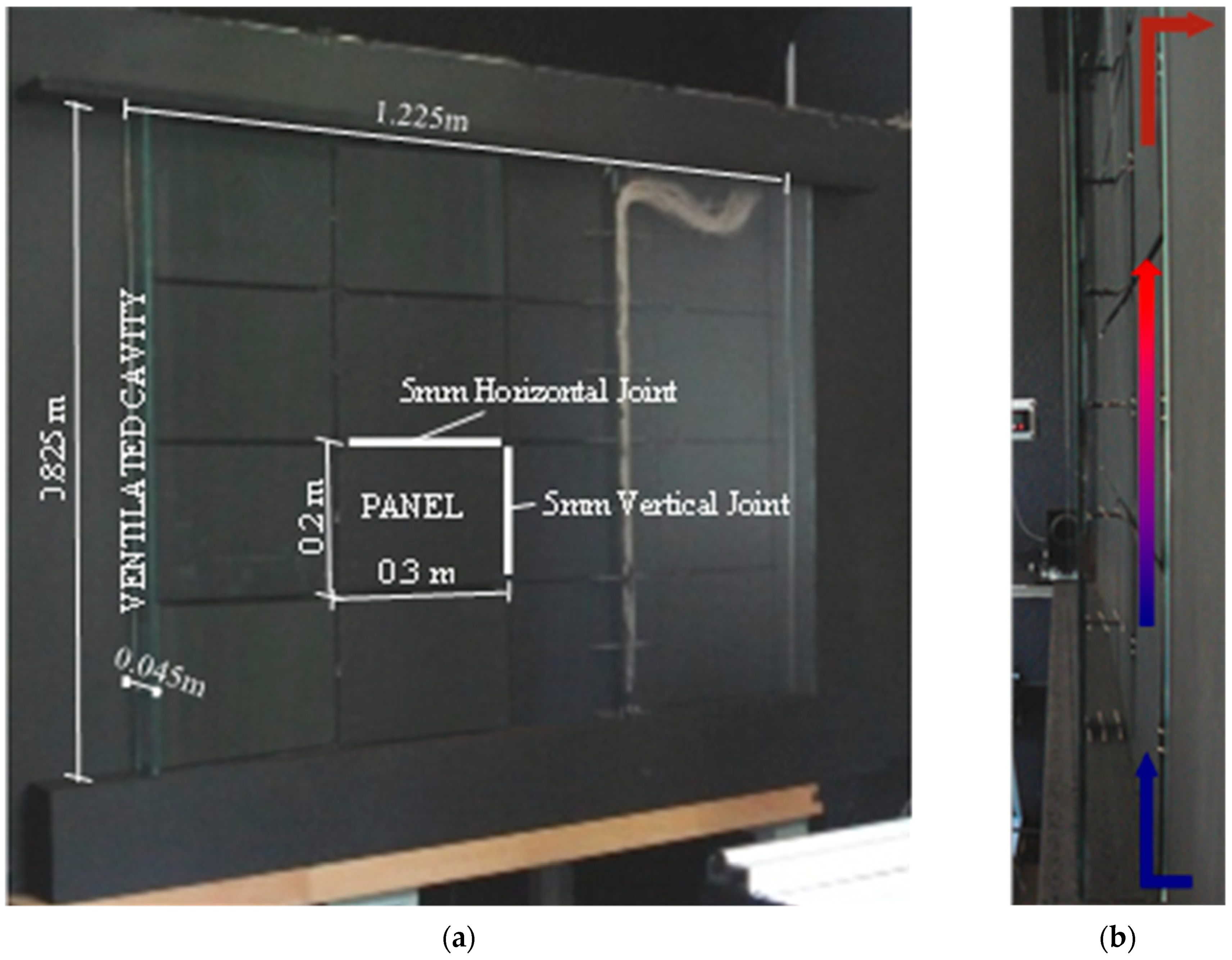


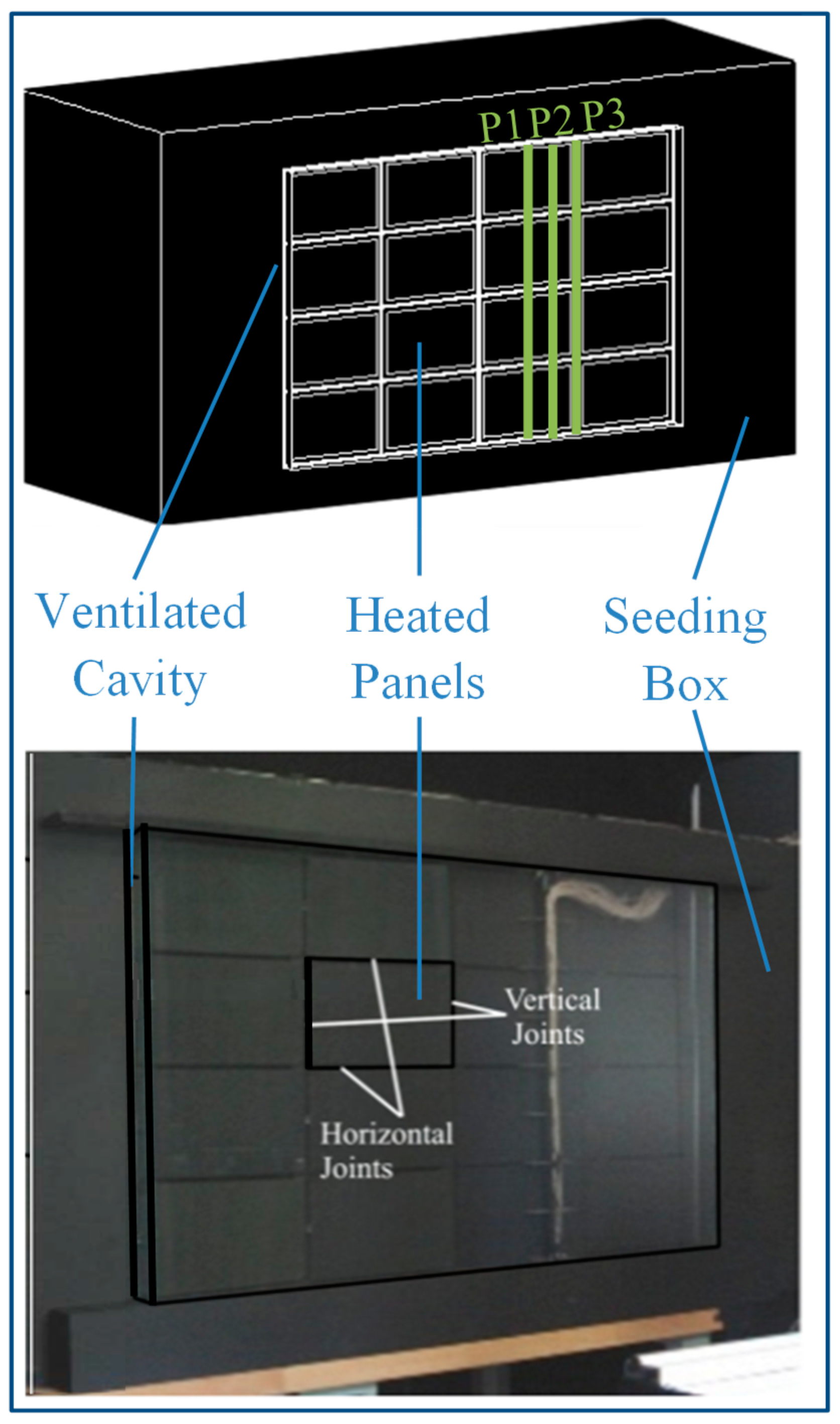
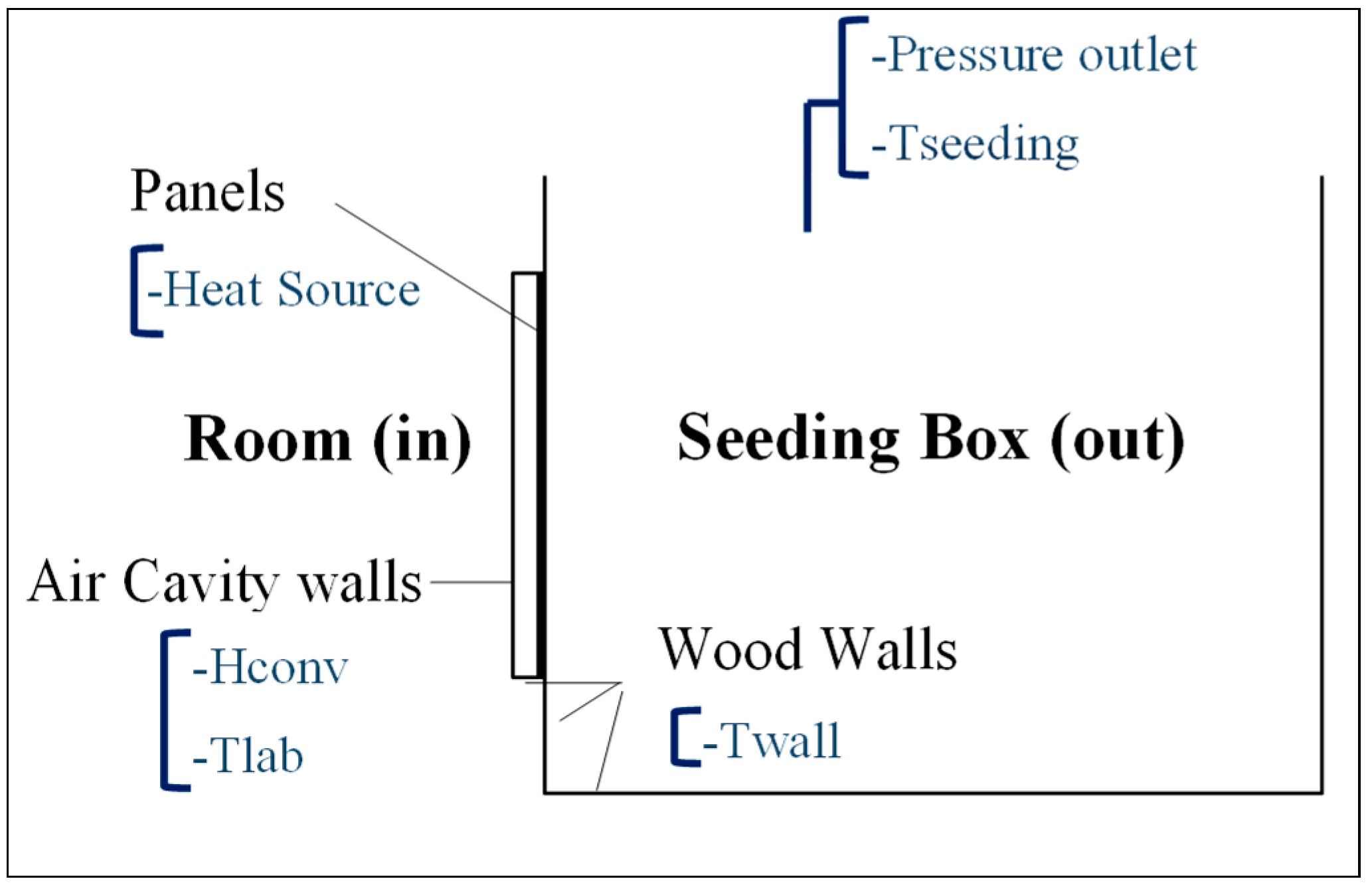
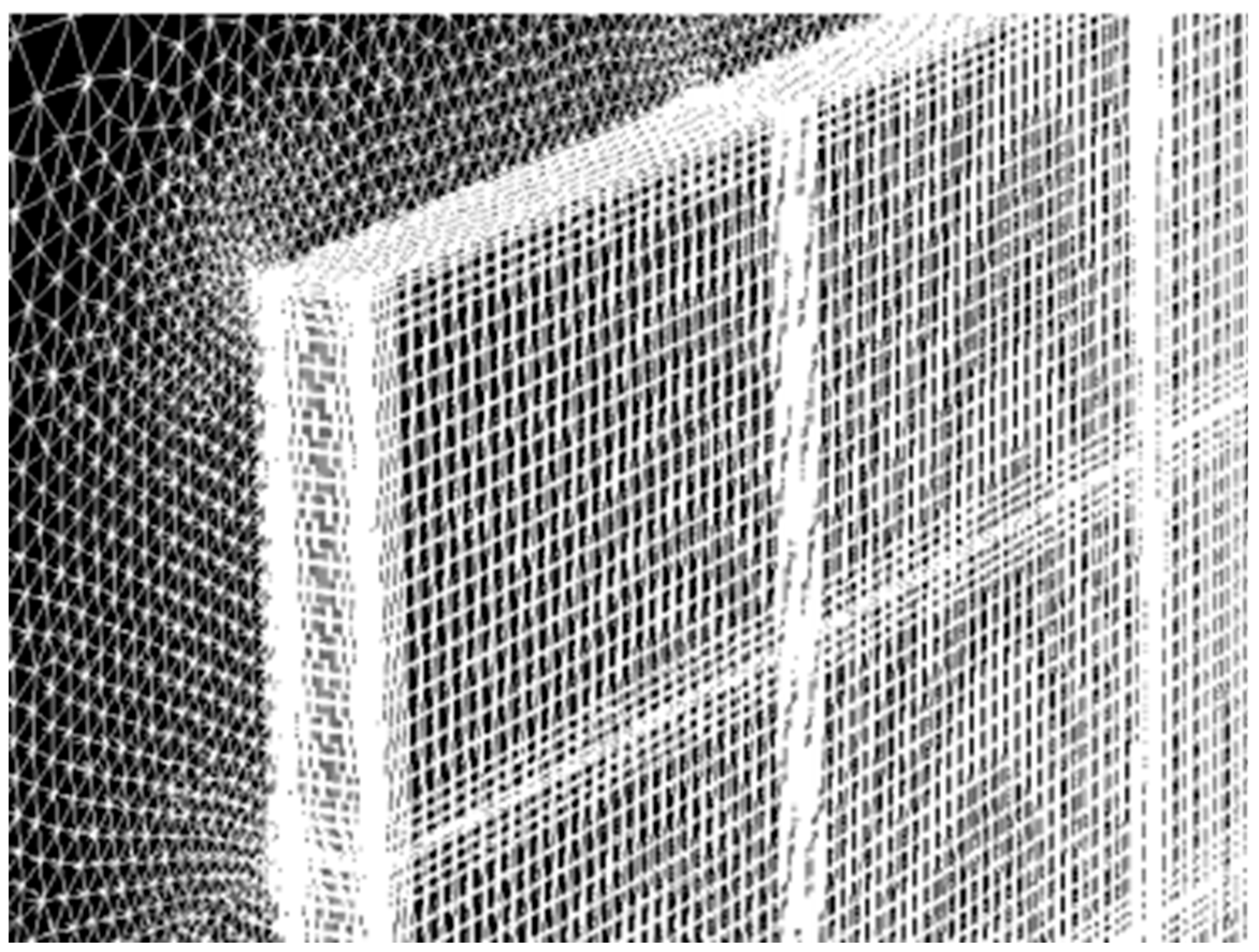
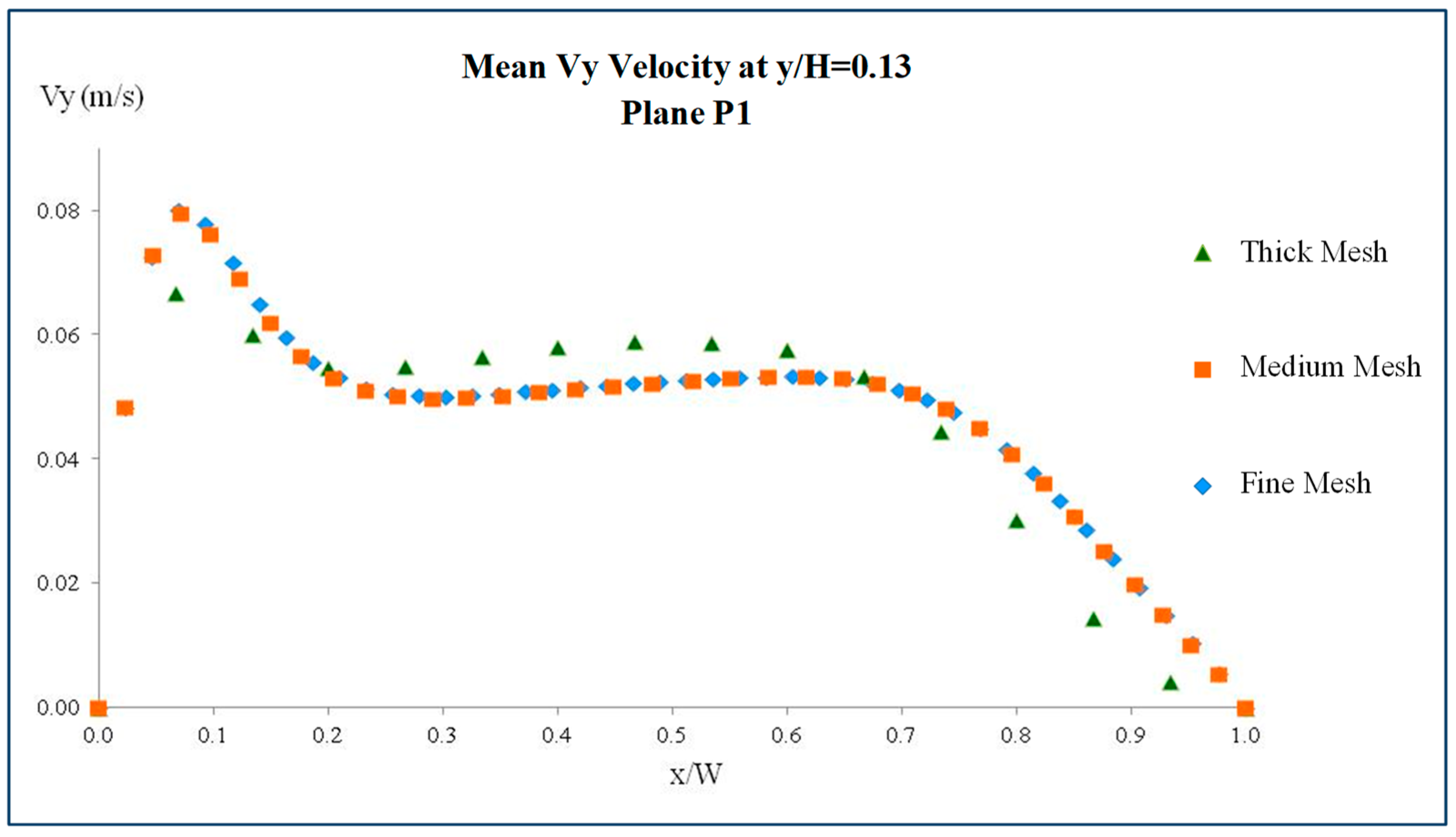
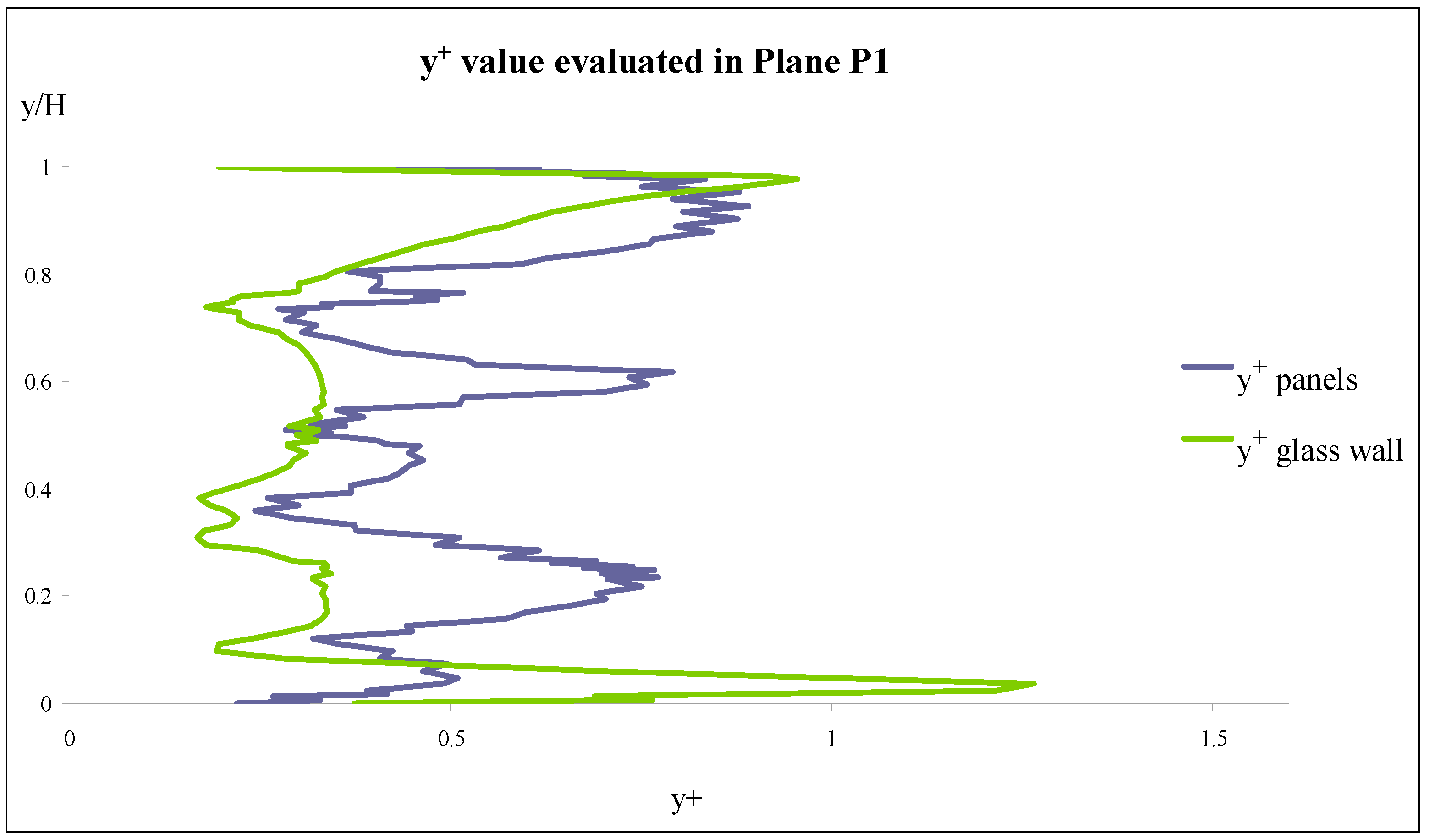
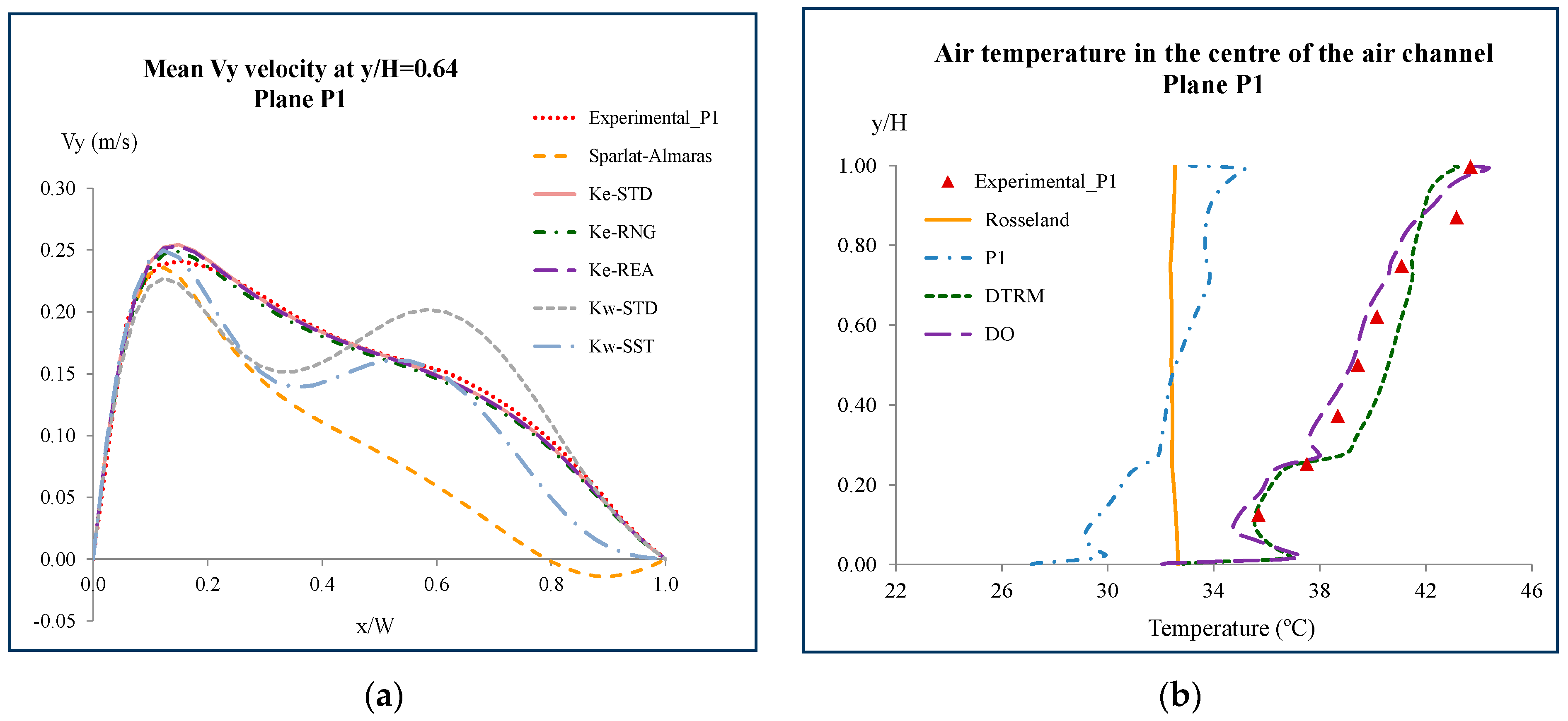
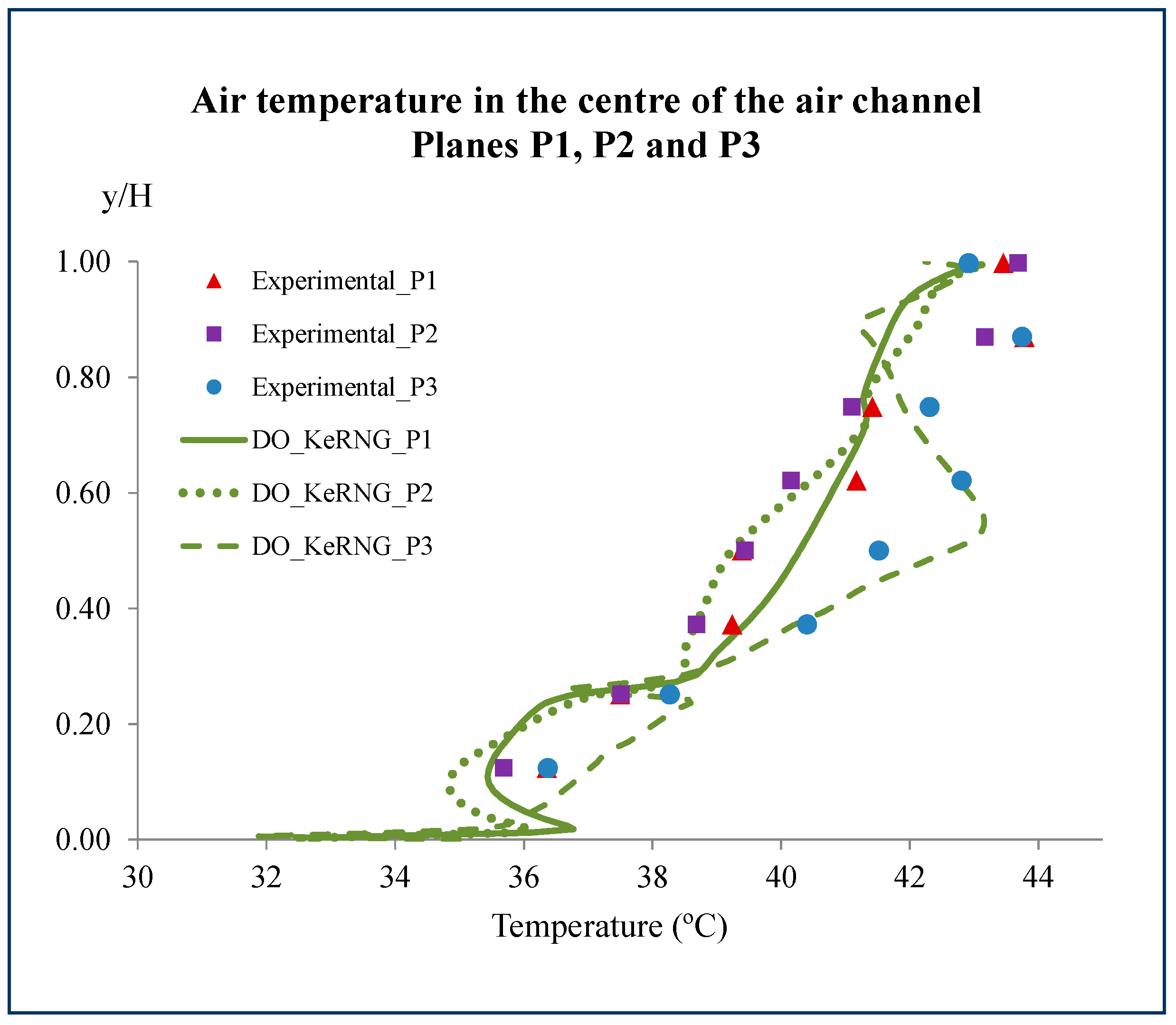
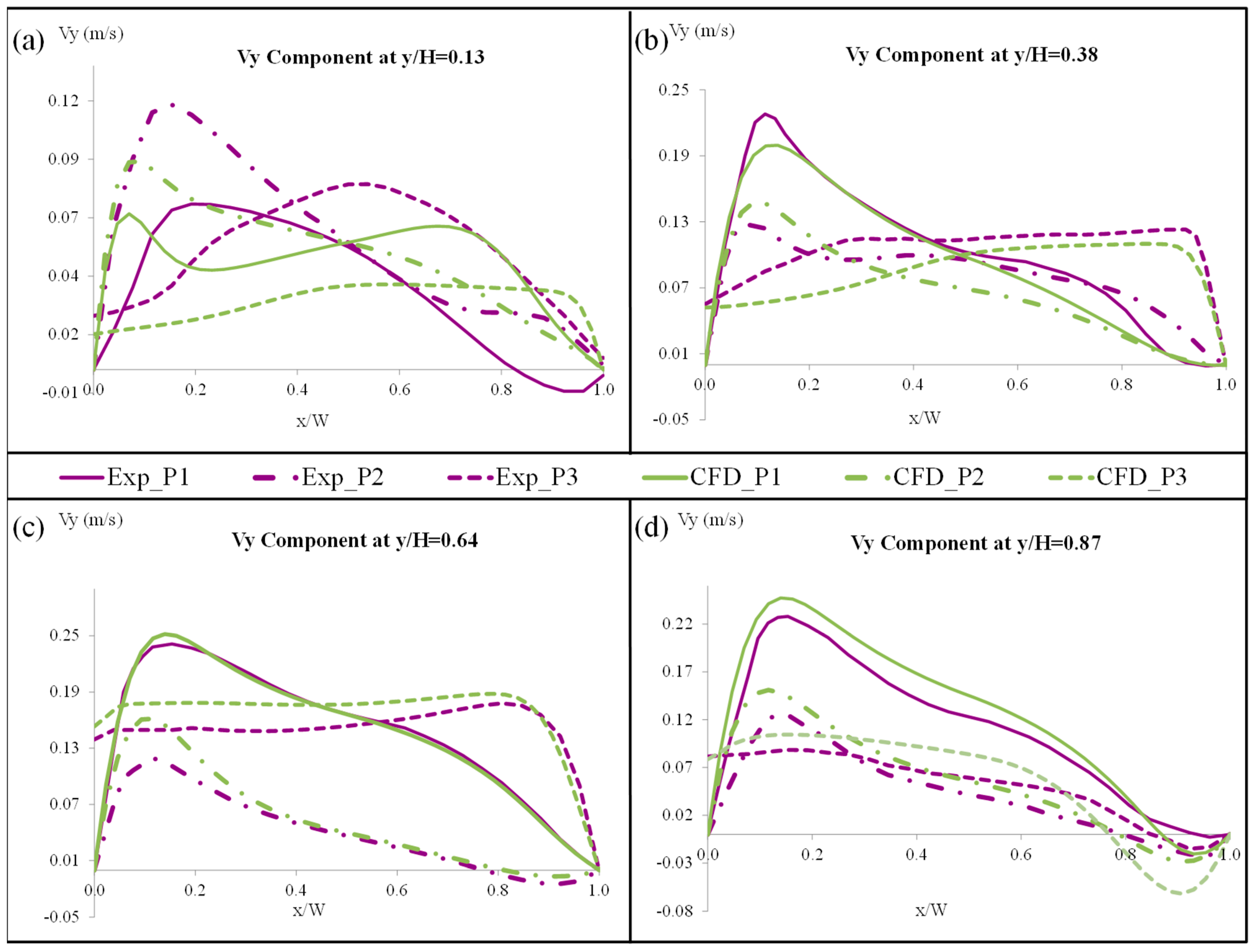
| Layer | Material (Wide × High) | Thickness (mm) | Thermal Conductivity (W/(m·K)) | Density (Kg/m3) | Heat Capacity (J/(kg·K)) |
|---|---|---|---|---|---|
| Outer Skin | 16 Aluminium Panels (0.3 × 0.2 m2) | 1 | 235 | 2699 | 896 |
| Ventilated Cavity | Air (25 °C) (1.225 × 0.825 m2) | 45 | 0.0255 | 1225 | 1007 |
| Inner Skin | Glass (1.225 × 0.825 m2) | 5 | 0.81 | 2719 | 871 |
| Seeding Box | Wood Boards (2.0 × 1.1 m2) | 19 | 0.173 | 700 | 2310 |
| Mesh Density | Total Number of Cells (Millions) | Cavity Width Divisions | Distance from the Cell Node to the Wall (In the Width of the Cavity) |
|---|---|---|---|
| Thick Mesh | 0.5 | 15 | 3 mm (uniform distance in air cavity width) |
| Medium Mesh | 0.8 | 33 | 1 mm (near inner wall) |
| Fine Mesh | 1 | 43 | 1.05 mm (uniform distance in air cavity width) |
© 2019 by the authors. Licensee MDPI, Basel, Switzerland. This article is an open access article distributed under the terms and conditions of the Creative Commons Attribution (CC BY) license (http://creativecommons.org/licenses/by/4.0/).
Share and Cite
Sánchez, M.N.; Giancola, E.; Blanco, E.; Soutullo, S.; Suárez, M.J. Experimental Validation of a Numerical Model of a Ventilated Façade with Horizontal and Vertical Open Joints. Energies 2020, 13, 146. https://doi.org/10.3390/en13010146
Sánchez MN, Giancola E, Blanco E, Soutullo S, Suárez MJ. Experimental Validation of a Numerical Model of a Ventilated Façade with Horizontal and Vertical Open Joints. Energies. 2020; 13(1):146. https://doi.org/10.3390/en13010146
Chicago/Turabian StyleSánchez, María Nuria, Emanuela Giancola, Eduardo Blanco, Silvia Soutullo, and María José Suárez. 2020. "Experimental Validation of a Numerical Model of a Ventilated Façade with Horizontal and Vertical Open Joints" Energies 13, no. 1: 146. https://doi.org/10.3390/en13010146






